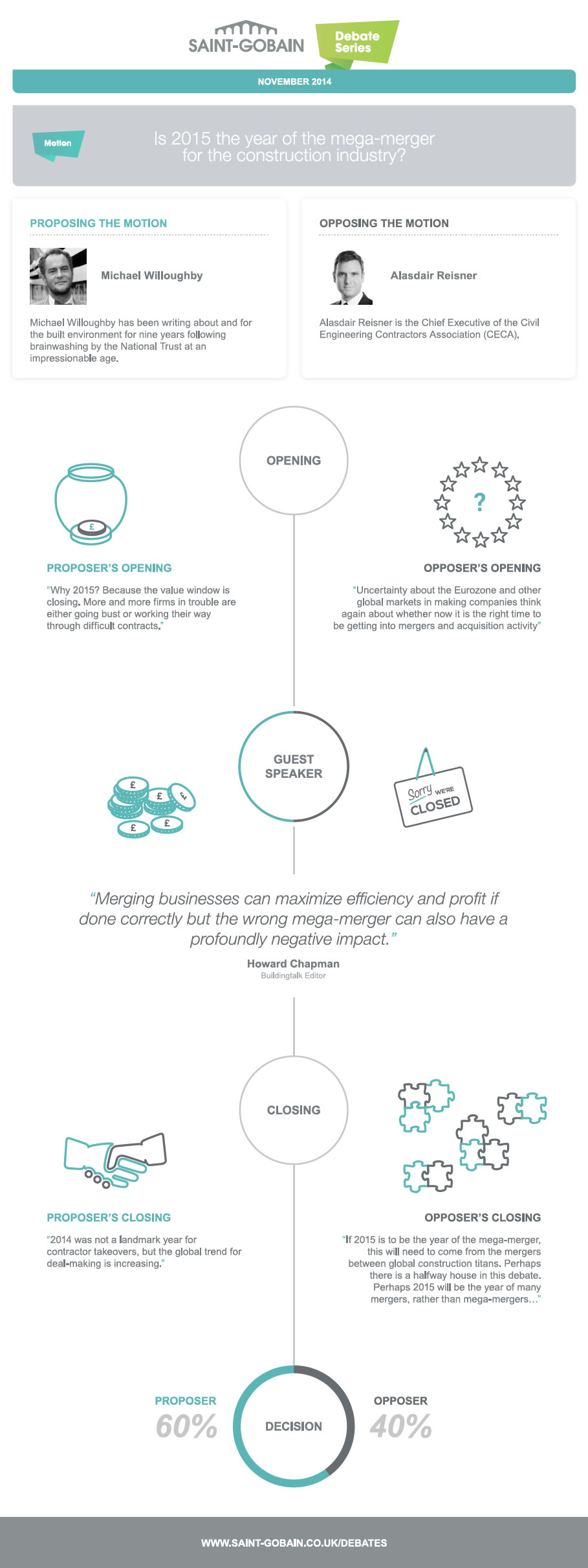
Saint-Gobain debate considers merging future of construction
Last year, the top 100 contractors in the construction industry saw profitability take a sharp decline, with total profits falling by a third from
£1.2 billion to only £791 million. This reflected increasing concerns about margins squeezed by low bidding and excessive competition encouraged by contractor’s clients. Company Watch reported that the total turnover of the industry had hardly moved, with a measly 1.1% rise since 2012.
Link above to Saint-Gobain Debate infographic
These statistics demonstrate the struggle that the industry faces, and how finding ways to overcome such problems has become a priority to many businesses. Mergers and acquisitions (M&A) have received a huge amount of media attention this year, with much interest around two key players in the industry; Carillion and Balfour Beatty who agreed and then disagreed a takeover deal that would have created a huge impact on the financial aspects within the industry.
One of the most attractive deals in the history of the industry came from that of R O’Rourke & Son and Laing Construction, when the concrete contractor purchased the firm from John Laing for just one humble English pound. Issues stemming from the National Physical Laboratory and Cardiff Millennium Stadium nearly destroyed Laing, but thanks to the introduction of a flatter management structure introduced by Ray O’Rouke, senior directors had a better idea of what was happening on site.
The topic of mergers and acquisitions is important to the industry, and this was the focus of the latest Saint-Gobain online debate. Construction writer, Michael Willoughby, and Chief Executive of the Civil Engineering Contractors Association (CECA), Alasdair Reisner, argued the motion, Is 2015 the year of the mega-merger?’
The following comments are highlights taken from the statements made during the debate:
Michael, speaking in favour of the motion:
In 2014, the construction industry, like the Roman god Janus, wears two faces.
One, etched with care and worry, looks back to the five-year slump in output, starting with the crash of 2008; the other, dynamic, excitable and wild-eyed greedily stares at the fast-growing, even overheating, industry which finally emerged in May 2013, spearheaded by low interest rates, government programmes and pent-up demand. Last week, Mace’s cost-consultancy division predicted London tender-price inflation of 4.5% over the next two years.
These two faces, or two sets of market conditions, are so sharply different, and the construction project life-cycle so long, that a number of contractors are struggling to keep their heads the two faces together.
So, with output up 4.8% year-on-year and forecast to rise, all firms are drawn to and bidding on all the goodies on offer. The market lacks competition in some areas, and profit margins are rising again. It’s a seller’s market.
BUT then there are the mistakes of the past. Struggling to keep body-and-soul together during the five, lean years, firms took on projects at aggressively competitive prices. Now input costs such as labour and materials are rising, and for some firms all will have been for nothing. They have won the battle but will lose the war. Nine firms issued profit margins in the first quarter of 2014 compared with seven throughout the whole of the preceding year.
Alasdair, speaking against the motion:
As the days darken and the shops start the annual process of foisting Christmas knick-knacks on the unwary, it seems a good time to take stock on the year just passed and gaze into our crystal balls to see what 2015 might offer.
Some things are easy bets. Will 2015 be the year of politicians promising to build, build, build’ and then doing an immediate reverse ferret the moment they pick up the keys to 10 Downing Street? The odds on that seem short.
Will 2015 see increasing challenges for industry to match available resources to demand from a rebounding sector? You betcha. And you can also bet that industry will find answers to this question, as it always does.
But will, as has been suggested, 2015 be the year of the mega-merger? Well on that one I’m not so sure.
For starters, it would have to be going some to top the last 12 months. Thomson Reuters reports that 2014 saw global deal-making hit a five year high. In our sector that meant bumper deals such as the Lafarge Tarmac-Holcim tie-up, Aecom-URS barnstorming surprise in mid-summer and WSP picking up Parsons Brinkerhoff. It’s becoming increasingly difficult to see where the bid targets might come from that would top these deals in terms of size.
But more importantly there must also be a big question about whether the appetite is still there? While 2014 has seen the City banking a roster of big deals, the dying days of the year have seen a hardening of sentiment. Uncertainty about the Eurozone and other global markets is making companies think again about whether now is the right time to be getting into mergers and acquisition activity. Deflation is stalking the markets and the prospect of the Chinese economy landing with a thump after years of growth is adding further jitters to companies thinking about whether to go on the acquisition trail. After all, why buy in 2015 if you can pick up the same cheaper by keeping your power dry and waiting for the storm to pass.
Debate result
The online opinion poll for the debate resulted in Michael being crowned the victor, with 60% voting in favour of the motion. This suggests that the public believe M&A activity in construction could bring great opportunities to the industry.
It takes courage for firms to take the plunge, however the benefits can be great, and could mean great results in 2015.
Visit Saint-Gobain UK and Ireland's website
Saint-Gobain UK & Ireland
Saint-Gobain House
Binley Business Park
Binley
Coventry
CV3 2TT
United Kingdom
Visit Supplier's page
Latest news

11th April 2025
Don’t Do a Dave! It’s Time to Lock FIT Show 2025 in Your Calendar!
It’s that time again – FIT Show is back! You could be forgiven for thinking there won’t be much new to see when FIT Show returns to the NEC from 29 April – 1 May. Wrong!
Posted in Articles, Building Industry Events, Building Industry News, Building Products & Structures, Building Services, Continuing Professional Development (CPD's), Exhibitions and Conferences, Information Technology, Innovations & New Products, Restoration & Refurbishment, Retrofit & Renovation, Seminars, Training
11th April 2025
Insight Data: Boost construction success with project and prospect data
For those working in construction – in whatever capacity – the last few years haven’t been much fun. And according to the latest statistics, it would seem the challenges are continuing – Alex Tremlett, Insight Data’s Commercial Director, has more…
Posted in Articles, Building Industry News, Building Services, Information Technology, news, Research & Materials Testing
11th April 2025
ASSA ABLOY EMEIA: Learn how to tackle the security challenges of digitalising access with insights from industry experts
In a new series of videos, experts in various specialisms within ASSA ABLOY share their expertise on digital access, including the complexities to overcome and the range of benefits for those who get digital access right…
Posted in Access Control & Door Entry Systems, Architectural Ironmongery, Articles, Building Industry News, Building Products & Structures, Building Services, Doors, Facility Management & Building Services, Information Technology, Innovations & New Products, Posts, Restoration & Refurbishment, Retrofit & Renovation, Security and Fire Protection, Videos
10th April 2025
Geberit completes 150 Acts of Kindness
Geberit has raised nearly £14,000 for various charities through its ‘150 Acts of Kindness’ initiative, a year-long programme of fundraising and volunteering to mark the company’s 150th anniversary in 2024.
Posted in Articles, Bathrooms & Toilets, Bathrooms, Bedrooms & Washrooms, Building Industry Events, Building Industry News, Building Products & Structures, Building Services, Charity work, Drainage, Interiors, Pipes, Pipes & Fittings, Plumbing, Restoration & Refurbishment, Retrofit & Renovation
 Sign up:
Sign up: